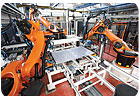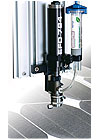
The recent Fukushima nuclear disaster in Japan is expected to jump-start demand for solar modules. Indeed, several recent announcements indicate that the future looks bright for the solar power industry:
Bloomberg New Energy Finance predicts the cost of large solar photovoltaic projects, which currently average $3.02 per watt, will decline to $1.45 per watt by the end of this decade.
The U.S. Department of Energy is investing $29 million in its new SunShot initiative, which is designed to increase the efficiency of solar manufacturing processes and optimize the performance of solar installations. The initiative’s ambitious goal is to reduce the total cost of solar energy systems by 75 percent over the next decade.
Total SA, a large French oil company, is spending more than $1 billion to buy a controlling stake in SunPower Corp., a leading manufacturer of solar panels and systems.
General Electric Co. plans to invest $600 million to build a new factory that will assemble thin-film solar modules that can be mass-produced using a roll-to-roll manufacturing process.
The Solar Energy Industries Association claims that the U.S. solar industry was one of the fastest growing sectors of the economy during the first half of 2011. During the first three months of this year, the United States installed 252 megawatts of grid-connected photovoltaics (PV), a 66 percent year-over-year growth. Domestic PV module production during the same time period amounted to 348 megawatts, a 31 percent increase over 2010.
That’s good news for thermal joining processes, such as welding and soldering. Both of these old-school assembly technologies are used to mass-produce solar panels.

An ultrasonic welder was used to generate a continuous seam weld that connects each cell in the photovoltaic glass. Photo courtesy Branson Ultrasonics Corp.
Welding Applications
Photovoltaic modules typically consist of an aluminum frame that contains multiple cells that are connected together. Modules can be connected to form even larger units called arrays, which can be interconnected to produce more power.Whether they use thin-film, concentrated or semimonocyrstalline cells, PV modules are similar to many other products that require thermal joining. However, one key difference has to do with product warranties.
Photovoltaic modules typically have a warranty that lasts several decades, so joints must be robust and able to withstand continuous thermal cycling over the life of the module.P“The performance of interconnects over a 30-year life cycle is now more important than ever,” claims one industry observer.
“The PV module manufacturing process can be divided into two distinct phases-pre and post lamination,” says Detlev Ziesel, group manager of alternative energy and technology at KUKA Systems Corp. North America. “Prelamination is very similar to products and processes used in the semiconductor industry in regards to cycle time, cleanliness and throughput requirements. Postlamination is very similar to assembly processes used in general industry.
“However, from a component aspect, the cells are extremely fragile,” adds Ziesel. “[And, there’s a need to] meet and exceed ever tighter build tolerances.”
According to Ziesel, most welding applications occur within the PV cell matrix, which involves joining tin-coated copper ribbons, stringers, bus bars and junction boxes.
“Although every PV manufacturer’s design is unique, the modules, panels and j-boxes all have conductive interconnects that require a precision joining process,” explains John DiGiacomo, regional manager at Miyachi Unitek Corp., which specializes in resistance and laser welding equipment. “The requirements of the solar industry are similar to other industries-a robust precision joining process [that allows engineers to] control, monitor and verify the results.”
“The procedures we have in place to optimize our joining technologies for PV module manufacturing are the same procedures we use in other industrial segments, such as automotive, aerospace, electronics, batteries or medical devices,” claims DiGiacomo. “However, the PV module assembly market has become one of our fastest-growing segments.”
The solar industry is fragmented by several different types of materials and processes. For instance, while copper bus, ribbon and wire interconnects plated with tin or silver are commonly used materials, thin-film PV and concentrated PV (CPV) applications use a variety of other materials and substrates.
“With the competitiveness between the different solar power technologies, and with existing power generation, squeezing every penny out of the cost of the product and its manufacture often means the difference between success and failure,” explains Ward Palmer, sales manager at CHAD Industries Inc., a systems integrator that specializes in semiconductor and solar cell automation.
“With CPV products, the cells can be connected to the substrate using either wire bonding or welded interconnects,” Palmer points out. “The tradeoff is between cost and robustness. In addition, connections of the lead wires may be soldered or welded in place. The box build, however, typically [relies on] conventional screws or rivets.
“Automation equipment for CPV products falls somewhere between standard and custom equipment, as each manufacturer has its own unique product design and manufacturing requirements,” adds Palmer. “Typically, they all require several types of adhesives, as well as either soldered or welded connections.
“Within that context, there is the need for flexible precision alignment typically featuring robots and vision,” says Palmer. “Throughput without yield loss is always the challenge when trying to get the greatest value from a production line.”

Ultrasonic welding joins aluminum foil to metallized glass on photovoltaic cells. Photo courtesy Sonobond Ultrasonics
Ultrasonic Benefits
The solar industry is investing in ultrasonic welding equipment because of its ability to join aluminum, copper, glass and other dissimilar materials that are used in solar modules.“The coating on the glass often differs from the tab or bus bar material, and the ultrasonic approach works well in this condition,” says Home Mojal, product manager at Telsonic Solutions Inc.
“Soldering and adhesive tapes had been the conventional ways of bonding, but ultrasonic welding is rapidly gaining ground,” claims Mojal. “This is mainly due [to benefits such as] true metallurgical bonds, very little localized temperature rise, quality monitoring and ease of automation.”
The thinness of aluminum, copper, glass and other materials used in solar panels is ideal for ultrasonic welding applications. “Aluminum ribbons are typically about 0.001or 0.002 inch thick,” says Joe Stacy, national sales manager for metal welding at Branson Ultrasonics Corp. “Welding to glass is challenging, and we expect it to get even thinner in the future. That should make for some interesting applications in the next three or four years.”
The sensitive nature of solar panels presents some unique ultrasonic welding challenges. For instance, engineers must consider material thickness consistency while keeping distortion to a minimum. Excessive contamination and oxidation in the weld area must also be addressed.
“The overall dimensions and the fragile nature of the PV cells are different from the typical applications for ultrasonic metal welding,” notes Mojal. “For example, due to the sensitive nature of the active layer of a thin-film application, amplitude and force regulation have to be very precise. At the same time, since the glass itself acts as an anvil, special attention must be given to ensure correct clamping of the module.”
Because of the thin materials involved, Stacy claims that “tool life is phenomenal. It doesn’t take a lot of power to make a weld. As a result, there’s much less wear than we see in automotive applications.”
Branson offers both 40- and 60-kilohertz welders for solar panel assembly. The company also developed its MWX100 actuator for solar applications.
“It can be mounted in eight different configurations, which allows many angles, including table, gantry and surface mount,” says Stacy. “We’re also experimenting with new coatings and other R&D efforts that should be ready later this year. For instance, we’re developing titanium horns that feature nonstick surfaces.”
According to Stacy, the solar field is extremely competitive. “It’s worse than batteries,” claims Stacy. “Everyone is trying to get a leg up.”
Other welding equipment suppliers have also been attracted to the burgeoning solar field. For instance, Sonobond Ultrasonics developed the MS-5010PV ultrasonic photovoltaic modular system. The 50-kilohertz machine does not distort materials or crack the glass panels in PV cells as it seams welds.
“It’s perfect for welding aluminum foil to the metallized glass on the photovoltaic cells that comprise solar panels,” claims Janet Devine, Sonobond’s president. “[The equipment] creates an ultra-reliable, solid-state metallurgical bond. The resulting interconnects between the PV cells generate an array with excellent conductivity. And, the process takes just seconds, while using no fluxes, tapes, solder or other consumables.”

Soldering plays a key role in solar panel production. Photo courtesy Nordson EFD
Soldering Plays a Key Role
It’s difficult to make a solar panel without some type of soldering. The amount of soldering required depends upon the type of module that’s being manufactured.In crystalline cell modules, cells are first soldered into serial strings, then soldered in parallel connections that are soldered into the junction box. “Pretinned copper ribbon is typically used for the stringing applications,” says Terry Dunbar, application development manager at Nordson EFD. “Flux is applied to either the ribbon or the cell’s bus bar to ensure good peel strength.
“While liquid flux is widely used, flux paste can be applied exactly where needed in the correct amount, is fully activated during the soldering process, and eliminates surface contamination commonly experienced with liquid flux,” Dunbar points out.” To enhance solder joint reliability, solder paste can be applied between the solar cell and pretinned ribbon, adding additional solder alloy to the joints.”
Inside the junction boxes there are also diodes that need to be soldered. Dunbar says this is usually done with solder paste, because the flux-rich formulation ensures the best possible joints by removing the oxides that can cause joint failures over time.
The use of back contacts in crystalline modules is also gaining in popularity. “Back contact cells tend to have a higher efficiency, because they use more cell area for light absorption to convert light into electricity,” explains Dunbar. “In back contact applications, all of the serial connections are made from the back side of the cell and the parallel connections are made at the ends of the strings. Flux-rich solder paste is used to ensure there is sufficient solder alloy for a reliable solder joint.”
In thin-film applications, the amount and type of soldering can vary greatly, depending on the design of the module. In some flexible building integrated photovoltaic modules, Dunbar says diodes are soldered onto busbars with solder paste to remove oxides and achieve the best possible joints.
In thin-film-on-glass applications, busbars are soldered directly to transparent conductive oxide glass using either pretinned ribbon with a spray coating of liquid flux or special low-temperature solder pastes.

A parallel gap welder head attaches an interconnect to a solar cell. Photo courtesy CHAD Industries Inc.
ASSEMBLY ONLINE
For more information on assembly technologies for photovoltaics, visit www.assemblymag.com for these articles:•Dispensing Shines in Solar Assembly.
•Conveyors: Passing Panels.
•Assembly in Action: Ultrasonic Welding Assembles Photovoltaic Cells.
